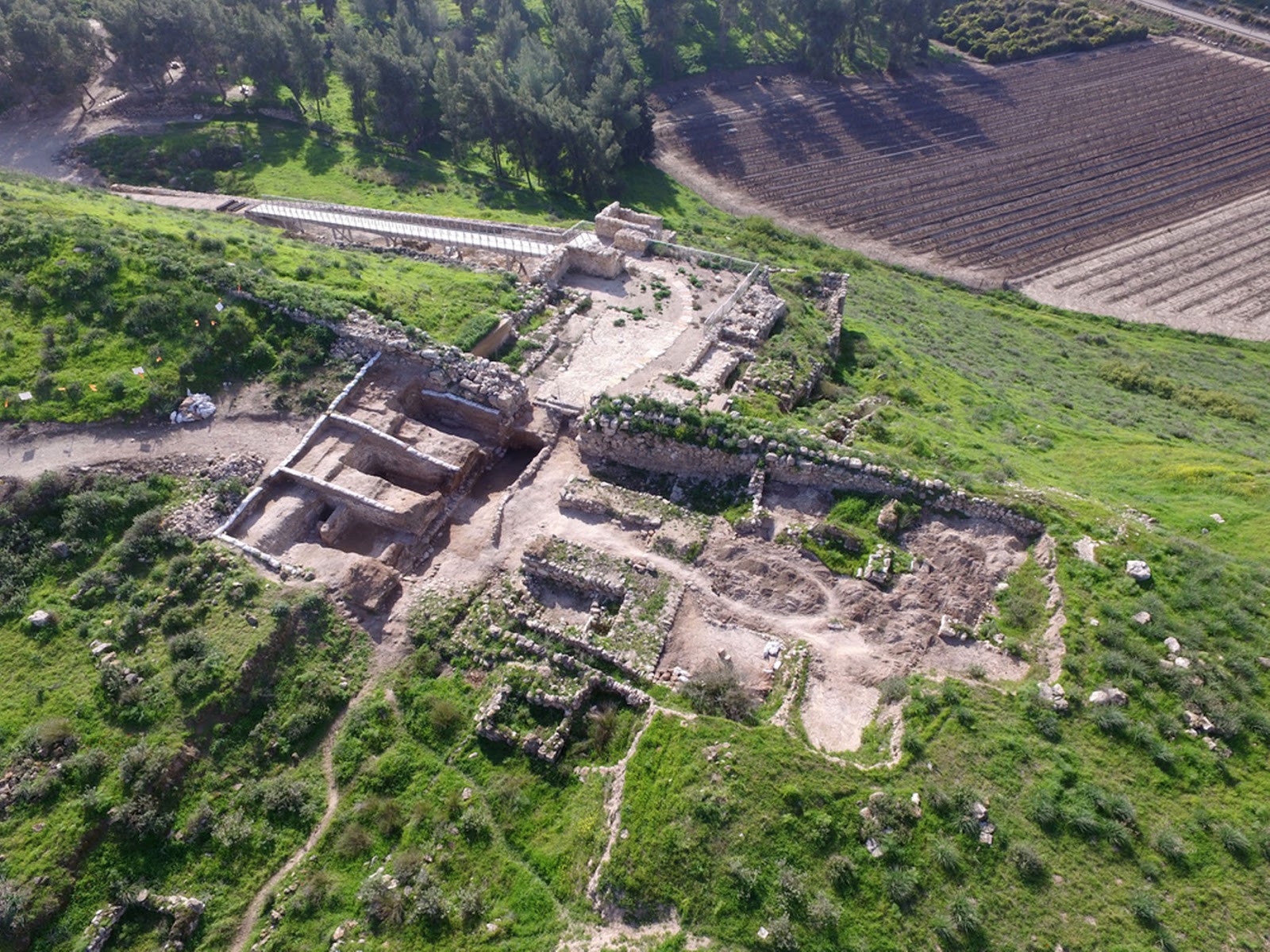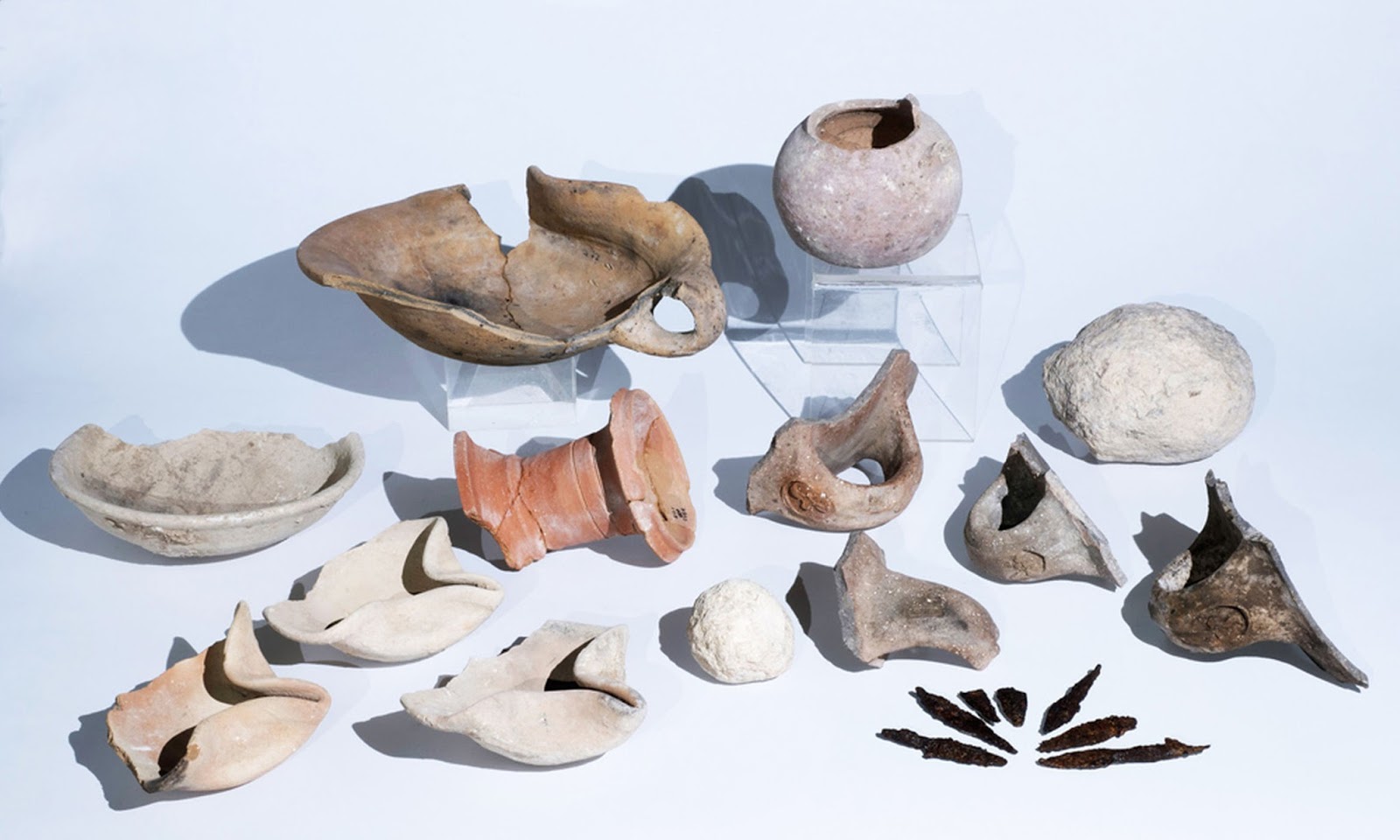It looks like you're using an Ad Blocker.
Please white-list or disable AboveTopSecret.com in your ad-blocking tool.
Thank you.
Some features of ATS will be disabled while you continue to use an ad-blocker.
10
share:
First Temple period gate-shrine unearthed at Israel's Tel Lachish National Park .
An important and unusual discovery was made in archaeological excavations that were carried out in the Tel Lachish National Park: a gate-shrine from the First Temple period (eighth century BCE) in what archaeologists perceive as compelling evidence of King Hezekiah’s efforts to abolish worship there, as described in the Bible: “He removed the high places, smashed the sacred stones and cut down the Asherah poles…” (II Kings 18:4).

The Tel Lachish National Park and the gate structure (left) that was exposed [Credit: Guy Fitoussi]
The continuation of the building is the gate-shrine whose walls were treated with white plaster. According to Ganor, “Steps to the gate-shrine in the form of a staircase ascended to a large room where there was a bench upon which offerings were placed. An opening was exposed in the corner of the room that led to the holy of holies; to our great excitement, we found two four-horned altars and scores of ceramic finds consisting of lamps, bowls and stands in this room. It is most interesting that the horns on the altar were intentionally truncated! That is probably evidence of the religious reform attributed to King Hezekiah, whereby religious worship was centralized in Jerusalem and the cultic high places that were built outside the capital were destroyed: “He removed the high places, smashed the sacred stones and cut down the Asherah poles…” (II Kings 18:4). Read more at archaeologynewsnetwork.blogspot.com...

During the excavation, many artifacts from the First Temple period were uncovered: oil lamps, seal impressions on jars and even arrowheads [Credit: Clara Amit, IAA]

A seal impression on a jar handle reading “lnhm avadi”, probably the name of a senior official that was in the Judahite administration [Credit: Clara Amit, IAA]

Experts think a toilet was placed at this location to end cultic worship at the gate shrine [Credit: IAA]
Those of you who remembered your biblical narrative would appreciate this find, I like this period because it was during the era of Kush as a world power clashing with the Assyrians over the Levant, final victory went to them after about a century, but not for long as they were undone by the Neo Babylonians, a very dynamic era, it was also the passing of the Bronze age , Iron would rule for the next 3000 or more years, an incipient Judaism would be codified shortly there after as captives in Babylon..
As the song goes
By the rivers of Babylon
klik the link and discover more.
edit on 30-9-2016 by Spider879 because: (no reason given)
a reply to: Spider879
Horns on the altar are a symbol of power (because bulls have them). The altar associated with the ark and the Jerusalem Temple had them too. People like Joab could claim sanctuary by grabbing hold of them.
Another way of desecrating altars was to burn dead human bodies on them, as Josiah did at Bethel.
In my opinion, giving a monopoly to Jerusalem benefited the Jerusalem priesthood more than it benefited the true interests of the religion.
Horns on the altar are a symbol of power (because bulls have them). The altar associated with the ark and the Jerusalem Temple had them too. People like Joab could claim sanctuary by grabbing hold of them.
Another way of desecrating altars was to burn dead human bodies on them, as Josiah did at Bethel.
In my opinion, giving a monopoly to Jerusalem benefited the Jerusalem priesthood more than it benefited the true interests of the religion.
It would really interesting if they found more evidence of Asherah worship.
That's a wonderful find! I was trying to determine if the temple was laid out in a way similar to the Egyptian temples (basically east-west, with
entrance on the east. Several small temples had three rooms at the west end where the mother-father-child trinity of deities was worshipped
(Ptah-Bastet-Maahes and Ptah-Sekhmet-Maahes were shown this way. I can't think of any temples for Isis-Osiris-Horus that were set up that way,
however.)
I looked up "horns of the altar" because I thought they had a Biblical reference. Here's what I found (this was the best explanation from multiple sources that all said the sam thing.)
So the horns indicate it's Jewish, but the broken horns indicate it's desecrated... perhaps because they started worshiping other gods there or perhaps because it was an older temple that worshiped Asherah-Yahweh-son trinity of deities.
I looked up "horns of the altar" because I thought they had a Biblical reference. Here's what I found (this was the best explanation from multiple sources that all said the sam thing.)
(qare-noth ha-mizbeach):
1. The Brazen Altar:
These projections at the four corners of the altar of burnt offering were of one piece with the altar, and were made of acacia wood overlaid with brass (Ex 27:2, "bronze"). In Ezekiel's altar-specifications their position is described as being on a level with the altar hearth (Ezek 43:15). Fugitives seeking asylum might cling to the horns of the altar, as did Adonijah (1 Ki 1:50), which is one proof among many that worshippers had at all times access to the neighborhood of the altar. On certain occasions, as at the consecration of Aaron and his sons (Ex 29:12), and a sin offering for one of the people of the land (Lev 4:30), the horns were touched with sacrificial blood. www.bible-history.com...
So the horns indicate it's Jewish, but the broken horns indicate it's desecrated... perhaps because they started worshiping other gods there or perhaps because it was an older temple that worshiped Asherah-Yahweh-son trinity of deities.
edit on 4-10-2016 by Byrd because: (no reason given)
originally posted by: Byrd
So the horns indicate it's Jewish, but the broken horns indicate it's desecrated... perhaps because they started worshiping other gods there or perhaps because it was an older temple that worshiped Asherah-Yahweh-son trinity of deities.
Another possibility is that it was a perfectly orthodox altar which happened to be outside Jerusalem. It seems to me that the Jerusalem establishment were determined to centralise things and create the "Jerusalem is the only place to worship" system which was operating in the time of Jesus;
"And he brought all the priests out of the cities of Judah, and defiled the high places where the priests had burned incense, from Geba to Beershaba", after which the deposed priests "ate unleavened bread among their brethren" (2 Kings ch23 vv8-9).
edit on 4-10-2016 by DISRAELI because: (no
reason given)
a reply to: Spider879
Only the ones left behind will be at the last temple (to learn), the rest will have been risen.
As far as the use of a commode, it will not necessary for 1000 years after being raised 'incorruptible.
In other words, after being raised, the human form will be changed into a species that has no 'innies or outties' parts. No distraction such as sexual contact is abound. Making situations like rape or corruption to be possible to/against another human being. Thoughts even of hunger are gone. A self-sufficient body cannot commit crimes, nor it has any need to. Imagine a world where you don't need to think about basic needs therefore how much the thinking process would greatly improve (for the good).
Only the ones left behind will be at the last temple (to learn), the rest will have been risen.
As far as the use of a commode, it will not necessary for 1000 years after being raised 'incorruptible.
1 Corinthians 15:52 In a moment, in the twinkling of an eye, at the last trump: for the trumpet shall sound, and the dead shall be raised incorruptible, and we shall be changed.
In other words, after being raised, the human form will be changed into a species that has no 'innies or outties' parts. No distraction such as sexual contact is abound. Making situations like rape or corruption to be possible to/against another human being. Thoughts even of hunger are gone. A self-sufficient body cannot commit crimes, nor it has any need to. Imagine a world where you don't need to think about basic needs therefore how much the thinking process would greatly improve (for the good).
edit on 4-10-2016 by dianashay because: (no reason given)
new topics
-
Pentagon UFO Hunter Reveals What He Knows About Aliens: Nothing
Aliens and UFOs: 41 minutes ago -
President Bidens Health is Declining Faster 5.8.2024 - He Should Stay Home.
2024 Elections: 1 hours ago -
Court of Appeals Agrees to Hear Trump Appeal to Flush Fani Willis
US Political Madness: 2 hours ago -
I "lost" a manuscript.
Rant: 4 hours ago -
Crocodile Reported in Water near a Buckinghamshire village in the UK
Pets: 5 hours ago -
Chris Cuomo, who pushed vaccine shots on CNN, admits Moderna vaccine destroyed his health
Mainstream News: 7 hours ago -
History Shows; Many Crisis Are Artificial I'm Order To Enslave People
Political Conspiracies: 8 hours ago
top topics
-
Chris Cuomo, who pushed vaccine shots on CNN, admits Moderna vaccine destroyed his health
Mainstream News: 7 hours ago, 20 flags -
Crocodile Reported in Water near a Buckinghamshire village in the UK
Pets: 5 hours ago, 6 flags -
History Shows; Many Crisis Are Artificial I'm Order To Enslave People
Political Conspiracies: 8 hours ago, 5 flags -
Court of Appeals Agrees to Hear Trump Appeal to Flush Fani Willis
US Political Madness: 2 hours ago, 5 flags -
President Bidens Health is Declining Faster 5.8.2024 - He Should Stay Home.
2024 Elections: 1 hours ago, 4 flags -
I "lost" a manuscript.
Rant: 4 hours ago, 3 flags -
Pentagon UFO Hunter Reveals What He Knows About Aliens: Nothing
Aliens and UFOs: 41 minutes ago, 0 flags
active topics
-
-@TH3WH17ERABB17- -Q- ---TIME TO SHOW THE WORLD--- -Part- --44--
Dissecting Disinformation • 878 • : Thoughtful3 -
I "lost" a manuscript.
Rant • 4 • : randomuser2034 -
History Shows; Many Crisis Are Artificial I'm Order To Enslave People
Political Conspiracies • 3 • : KnowItAllKnowNothin -
The Impeachment Inquiry of U.S. President Joseph R. Biden - Charges and Developments.
Political Issues • 432 • : matafuchs -
Social Security projected to cut benefits in 2035 barring a fix
Global Meltdown • 37 • : rdambroso -
The Acronym Game .. Pt.3
General Chit Chat • 7812 • : RAY1990 -
Israeli strikes on southern Gaza city of Rafah kill 22, mostly children, as US advances aid package
Middle East Issues • 188 • : dothedew -
Pentagon UFO Hunter Reveals What He Knows About Aliens: Nothing
Aliens and UFOs • 0 • : introufo2 -
Court of Appeals Agrees to Hear Trump Appeal to Flush Fani Willis
US Political Madness • 4 • : pianopraze -
Chris Cuomo, who pushed vaccine shots on CNN, admits Moderna vaccine destroyed his health
Mainstream News • 43 • : Anunak
10
